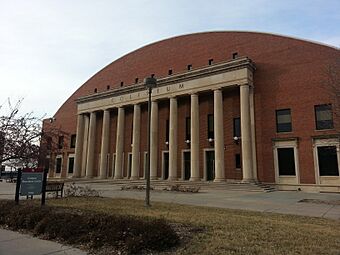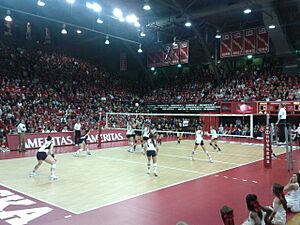Nebraska Coliseum facts for kids
 |
|

The Coliseum in 2017
|
|
| Address | 1350 Vine Street Lincoln, Nebraska |
|---|---|
| Coordinates | 40°49′17″N 96°42′9″W / 40.82139°N 96.70250°W |
| Owner | University of Nebraska–Lincoln |
| Operator | University of Nebraska–Lincoln |
| Capacity | 8,000 (1926–1991) 4,030 (1991–2013) |
| Construction | |
| Broke ground | 1924 |
| Opened | February 6, 1926 |
| Renovated | 1989–1992 |
| Closed | 2013 |
| Construction cost | $435,000 ($7.47 million in 2022 ) |
| Architect | Ellery L. Davis Walter Wilson |
| Tenants | |
| Nebraska Cornhuskers (NCAA) Men's basketball (1926–1976) Women's basketball (1975–1976) Volleyball (1975–1990, 1992–2013) Wrestling (1942–1990, 1992–2013) |
|
The Nebraska Coliseum (also called NU Coliseum) is a famous sports building at the University of Nebraska–Lincoln in Lincoln, Nebraska. It was once the main home for the university's men's basketball and volleyball teams.
After the volleyball team moved to the bigger Bob Devaney Sports Center in 2013, the Coliseum is now mostly used for student activities. It's a place where students can play sports and stay active.
Contents
The Nebraska Coliseum: A Historic Sports Arena
Building the Coliseum: A Look Back
Early Plans and Construction
After World War I, the University of Nebraska wanted to build a huge sports complex. This plan included a gym and a museum. However, the state faced tough economic times for farmers in the early 1920s. This meant they couldn't provide all the money they promised.
So, the big project was made smaller, focusing only on a football stadium. After the stadium was finished, people started planning a separate arena. This new arena would be just northeast of Memorial Stadium.
Architects Ellery L. Davis and Walter Wilson designed the Coliseum. They were both graduates of the university and had worked on other campus buildings. The money for the Coliseum came from ticket sales for football games in 1923.
Construction started in 1924, and the Coliseum opened in early 1926. It became the home for the university's indoor sports. The building had a cool Roman-style front entrance with ten columns. It was built with Indiana limestone and red brick, matching other buildings nearby.
Making it Better: Renovations
In 1987, the university announced plans to update the Coliseum. They also planned to build a new recreation center next to it. The updates included fixing and expanding the swimming pool, which had been closed in 1986.
They also added more offices and a jogging track above the main arena. These improvements started in 1989 and were finished in 1992.
New Uses for the Old Coliseum
Since the volleyball team moved out in 2013, the Coliseum is no longer the main home for any university sports teams. However, it's still used by the gymnastics teams for practice and office space.
The Coliseum is now part of the university's Campus Recreation Center. It is connected to another building called Cook Pavilion.
Basketball Memories at the Coliseum
First Games and Big Wins
The first event at the Coliseum was a basketball game on February 6, 1926. Even though the arena wasn't fully finished, 5,000 fans came to watch Nebraska play against Kansas. This was the biggest crowd for a basketball game at the school at that time. Kansas won the game 25–14.
Once construction was complete, the Coliseum could hold 8,000 people. Nebraska's men's basketball team played there for fifty years. They didn't always win a lot, but there were some exciting moments. In 1958, they had two memorable wins. They beat a Kansas team led by the famous player Wilt Chamberlain. They also defeated top-ranked Kansas State.
Moving On: New Homes for Basketball
In 1976, the men's basketball team moved to the new NU Sports Complex. This building was later named the Bob Devaney Sports Center.
The Nebraska women's basketball team also played their first season at the Coliseum in 1975–76. They then moved to the NU Sports Complex as well. Later, they moved to West Haymarket Arena. For many years, the Coliseum also hosted the state basketball championships for high school boys and girls.
Volleyball's Amazing Home Court
A Special Place for Volleyball
After the NU Sports Complex was built in 1976, the Coliseum became the main home for Nebraska's volleyball team. In 1991, the Coliseum was specially renovated for volleyball. Its seating capacity was reduced to 4,030.
This renovation made the Coliseum one of the few college arenas designed just for volleyball. It became known for its close and exciting atmosphere, which made the crowd noise incredibly loud. For decades, the Coliseum gave the team a big home-court advantage. Nebraska won an amazing 511 games and lost only 36 there. This included a fantastic record of 52 wins and 4 losses in the NCAA Division I tournament.
Record-Breaking Streaks
From 2004 to 2009, Nebraska set an NCAA Division I record with ninety wins in a row at home. This incredible streak ended against UCLA on September 14, 2009. That game was played at the Devaney Center and had a record-breaking crowd for a regular season game. Nebraska's win streak at the Coliseum itself ended two weeks later.
In 2001, Nebraska started a sellout streak that continued from the Coliseum to the Devaney Center. This streak eventually went past 300 sold-out games. It's the second-longest sellout streak in all college sports, right after Nebraska's football sellout streak.
More Than Just Sports: Other Events
In its early days, the Coliseum hosted fun swing dances for university students. It also welcomed famous people and important events.
In 1956, the legendary singer Elvis Presley performed a concert there. In 1960, Vice President Richard Nixon gave a speech. United States Senator Robert F. Kennedy also spoke at the Coliseum during his 1968 presidential campaign, just two months before he passed away unexpectedly.


